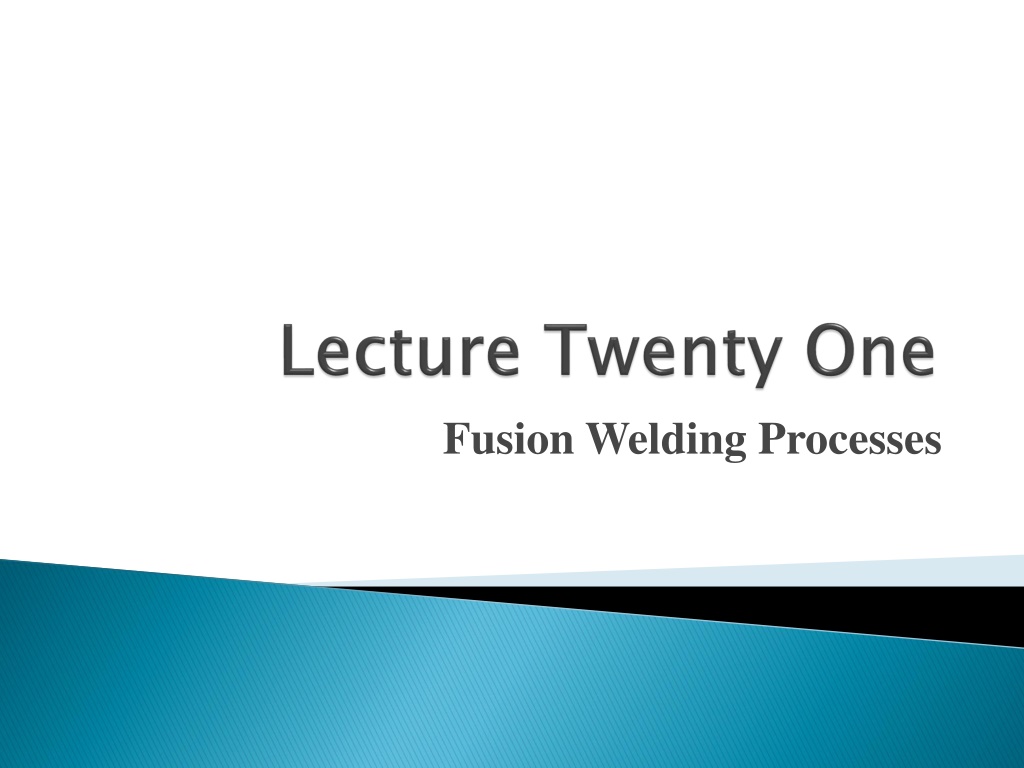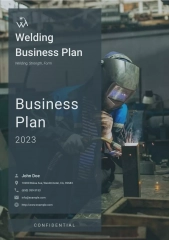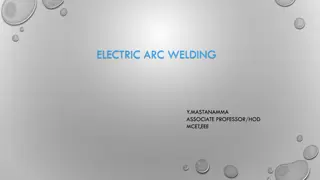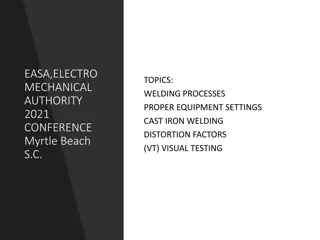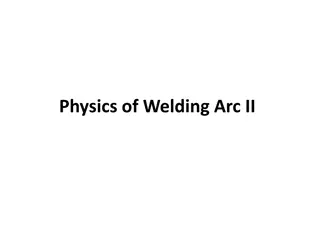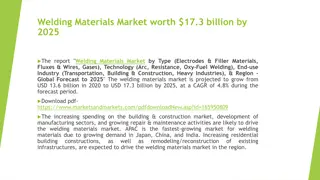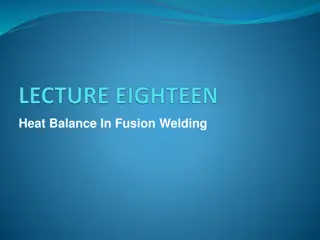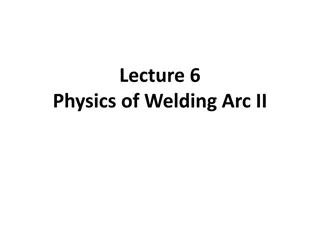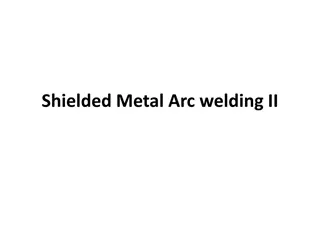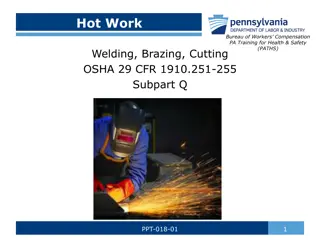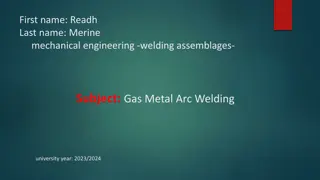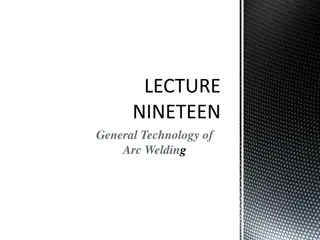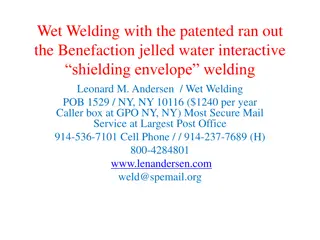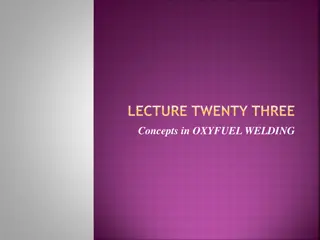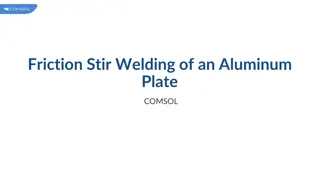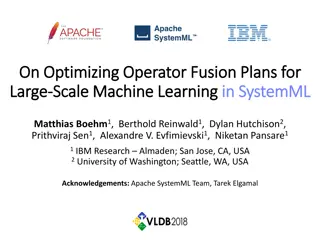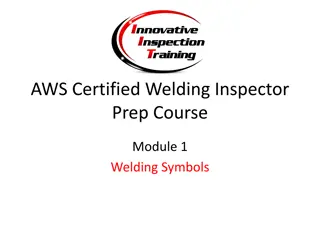Understanding Fusion Welding Processes
Fusion welding processes such as Plasma Arc Welding (PAW) and Electron-Beam Welding (EBW) utilize high temperatures and focused energy sources to create strong bonds between metals. PAW achieves extreme temperatures of 17,000°C, enabling it to weld almost any metal with advantages like good arc stability and high travel speeds. On the other hand, EBW uses a high-intensity stream of electrons to generate heat for welding, with a focus on power density and small welding areas. Both processes have specific applications, advantages, and limitations in various industries.
Download Presentation

Please find below an Image/Link to download the presentation.
The content on the website is provided AS IS for your information and personal use only. It may not be sold, licensed, or shared on other websites without obtaining consent from the author. Download presentation by click this link. If you encounter any issues during the download, it is possible that the publisher has removed the file from their server.
E N D
Presentation Transcript
is a special form of gas tungsten arc welding in which a constricted plasma arc is directed at the weld area. In PAW, a tungsten electrode is contained in a specially designed nozzle that focuses a high-velocity stream of inert gas (e.g., argon or argon hydrogen mixtures) into the region of the arc to form a high velocity, intensely hot plasma arc stream, as in Figure 21.1. Argon, argon hydrogen, and helium are also used as the arc-shielding gases. 21.1
Temperatures in plasma arc welding reach 17,000C (30,000F) or greater, hot enough to melt any known metal. The reason why temperatures are so high in PAW (significantly higher than those in GTAW) derives from the constriction of the arc. Although the typical power levels used in PAW are below those used in GTAW, the power is highly concentrated to produce a plasma jet of small diameter and very high power density. Plasma arc welding was introduced around 1960 but was slow to catch on. In recent years its use is increasing as a substitute for GTAW in applications such as automobile subassemblies, metal cabinets, door and window frames, and home appliances.
Owing to the special features of PAW, its advantages in these applications include good arc stability, better penetration control than most other AW processes, high travel speeds, and excellent weld quality. The process can be used to weld almost any metal, including tungsten. Difficult-to-weld metals with PAW include bronze, cast irons, lead, and magnesium. Other limitations include high equipment cost and larger torch size than other AW operations, which tends to restrict access in some joint configurations.
Electron-beam welding (EBW) is a fusion-welding process in which the heat for welding is produced by a highly focused, high-intensity stream of electrons impinging against the work surface as shown in figure (21.2). The electron beam gun operates at high voltage to accelerate the electrons (e.g., 10 150 kV typical), and beam currents are low (measured in milliamps). The power in EBW is not exceptional, but power density is. High power density is achieved by focusing the electron beam on a very small area of the work surface, so that the power density PD is based on ?? =?1?? 21.1 ?.? Where PD = power density, W/mm2(W/in2, which can be converted to Btu/sec-in2 by dividing by 1055.); f1 = heat transfer factor (typical values for EBW range from 0.8 0.95); E = accelerating voltage, V; I = beam current, A; and S.A = the work surface area on which the electron beam is focused, mm2(in2).
Typical weld areas for EBW range from 13 X 10-3to 2000 X10-3mm2(20 X 10-6to 3000 X 10-6in2). The process had its beginnings in the 1950s in the atomic power field. When first developed, welding had to be carried out in a vacuum chamber to minimize the disruption of the electron beam by air molecules. This requirement was, and still is, a serious inconvenience in production, due to the time required to evacuate the chamber prior to welding. The pump-down time, as it is called, can take as long as an hour, depending on the size of the chamber and the level of vacuum required. Today, EBW technology has progressed to where some operations are performed without a vacuum.
Three categories can be distinguished: (1) high-vacuum welding (EBW-HV), in which welding is carried out in the same vacuum as beam generation; (2) medium-vacuum welding (EBW-MV), in which the operation is performed in a separate chamber where only a partial vacuum is achieved; and (3) non vacuum welding (EBW-NV), in which welding is accomplished at or near atmospheric pressure. The pump-down time during work part loading and unloading is reduced in medium-vacuum EBW and minimized in non vacuum EBW, but there is a price paid for this advantage. In the latter two operations, the equipment must include one or more vacuum dividers (very small orifices that impede air flow but permit passage of the electron beam) to separate the beam generator (which requires a high vacuum) from the work chamber. Also, in non vacuum EBW, the work must be located close to the orifice of the electron beam gun, approximately 13 mm (0.5 in) or less. Finally, the lower vacuum processes cannot achieve the high weld qualities and depth-to-width ratios accomplished by EBW-HV.
Any metals that can be arc welded can be welded by EBW, as well as certain refractory and difficult-to-weld metals that are not suited to AW. Work sizes range from thin foil to thick plate. EBW is applied mostly in the automotive, aerospace, and nuclear industries. In the automotive industry, EBW assembly includes, steel torque converters, and transmission components. In these and other applications, electron-beam welding is noted for high-quality welds with deep and/ or narrow profiles, limited heat-affected zone, and low thermal distortion. Welding speeds are high compared to other continuous welding operations. No filler metal is used, and no flux or shielding gases are needed. Disadvantages of EBW include high equipment cost, need for precise joint preparation and alignment, and the limitations associated with performing the process in a vacuum. In addition, there are safety concerns because EBW generates X-rays from which humans must be shielded.
Laser-beam welding (LBW) is a fusion-welding process in which coalescence is achieved by the energy of a highly concentrated, coherent light beam focused on the joint to be welded as shown in figure (21.3). The term laser is an acronym for light amplification by stimulated emission of radiation. LBW is normally performed with shielding gases (e.g., helium, argon, nitrogen, and carbon dioxide) to prevent oxidation. Filler metal is not usually added. LBW produces welds of high quality, deep penetration, and narrow heat-affected zone. These features are similar to those achieved in electron-beam welding, and the two processes are often compared.
There are several advantages of LBW over EBW: no vacuum chamber is required, no X-rays are emitted, and laser beams can be focused and directed by optical lenses and mirrors. On the other hand, LBW does not possess the capability for the deep welds and high depth-to-width ratios of EBW. Maximum depth in laser welding is about 19 mm (0.75 in), whereas EBW can be used for weld depths of 50 mm (2 in) or more; and the depth-to-width ratios in LBW are typically limited to around 5:1. Because of the highly concentrated energy in the small area of the laser beam, the process is often used to join small parts.
